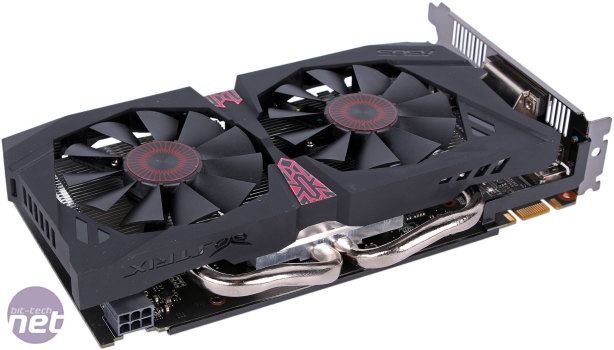Performance Analysis
The average frame rates are useful for giving us a general overview of performance and the differences between cards. Excluding the Middle Earth results for now, the GTX 950 Strix is around 4 percent quicker than the Gigabyte GTX 950 at both 1080p and 1440p. More significant is that is is, on average, 27 percent quicker than an AMD Radeon R7 370 at 1080p.Turning the cards above it, again excluding Middle Earth for now, Palit's GTX 960 averages a 17 percent lead at 1,920 x 1,080, while the R9 380 is ahead by 15 percent at the same resolution.
Unigine Valley yields similar outcomes, with the Palit GTX 960 emerging as 21 percent faster at 1080p, and the Asus GTX 950 Strix trumping its Gigabyte counterpart by just 3 percent in the same test.
Of course, minimum frame rates are even more important to the analysis. Going by these, 1080p is clearly the resolution this card is cut out for. Our games are all tested at maximum or near-maximum settings, and the GTX 950 Strix delivers frame rates within the 30-60fps sweet spot time and time again. With this card at this resolution, you'll only have to make tiny sacrifices to detail, if any, to achieve playable frame rates that are ripe for pairing with a G-Sync screen. That said, we'd admittedly prefer to put more cash towards our graphics hardware than a G-Sync screen. Turning to 1440p, only two of the six games surpass 30fps with this card – you simply need a beefier GPU to game comfortably with this many pixels.
There's one anomaly in all of this, and that's Middle Earth: Shadow of Mordor. Here, the issue seems to be the 2GB frame buffer, which is beginning to feel like it's not quite enough. There's a clear divide in the charts for this game between 2GB and 4GB models, with the £120 R7 370 4GB staying comfortably above 30fps while the £160-£170 GTX 960 fails to deliver even 25fps – Asus's card manages 17fps minimum. As we said in our review of Gigabyte's GTX 950, it begs the question of how much longevity there is in 2GB equipped cards. Sadly, there are no 4GB SKUs for us to compare to; the low performance may also be linked to the low 128-bit memory interface and resultant limits on memory bandwidth.
Back to the good news, and the Asus GTX 950 Strix is very efficient, causing a system power draw of just 244W, slightly less than the Gigabyte card despite being faster, and less than the R7 370 too, a card which it significantly outpaces. This bodes well for cooling, and indeed while it's not the coolest card around, Asus has sensibly prioritised noise reduction. The use of a fairly large heatsink allows it to achieve perfectly adequate cooling with a non-aggressive fan curve; we couldn't hear the card at all during test, with no coil whine emitted either. Remember, it switches off when under little to no load as well so you're guaranteed a whisper quiet gaming experience here.
The frequencies we saw through overclocking were great, with the memory speed being particularly insane. That said, the Strix card only manages the same minimum frame rate as the Gigabyte card when it too is overclocked, and in Unigine there's virtually zero difference. Also, a pre-overclocked GTX 960 is still faster in all instances. When overclocked, the card's temperature did increase a little but the card remained inaudible.
Conclusion
The Asus GTX 950 Strix retails for £25 more than a standard GTX 950, or put another way 20 percent. We said at the start of this review that it would have to deliver to be worth it and ultimately in this case we're not convinced it is. That's not to say it's a bad card; it isn't. It's one of the fastest on the market, silent in use, well made and an extremely potent overclocker, at least if our sample is anything to go by. Our only real gripe is the lack of a factory overclock on the memory.The trouble is, even all of this isn't enough to make up for the relatively lacklustre price-performance ratio, at least not in this price bracket. An extra £25-30 for premium components and a solid overclock is often well worth it at the higher ends of the market, but in the highly competitive mid-range that much more cash can net you the next model up. Indeed, the R9 380 and GTX 960 are convincingly faster, even with a massive overclock applied to the GTX 950 Strix, which at £150 is very much encroaching on their price territory.
The low noise and semi-passive cooling does stand out with this card, but even then you can get this with cheaper cards. For example, EVGA sells a model with even higher clocks for £10 less and it too features semi-passive cooling. While we haven't tested that card, the truth is that the GTX 950 is not a challenging GPU to cool. With average case airflow and a bit of tweaking to fan speeds, we'd you could run almost any GTX 950 silently while staying safely within the temperature limits. The Asus GTX 950 Strix makes a convincing case that it's the best GTX 950 around, so if that's what you're after it won't disappoint. The trouble is that with pricing as it is, you may as well just step up to the R9 380 or GTX 960.
-
Performance28 / 40
-
Features28 / 30
-
Value24 / 30


MSI MPG Velox 100R Chassis Review
October 14 2021 | 15:04













Want to comment? Please log in.